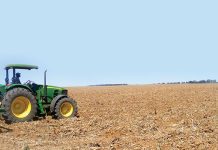Valuers distinguish between several types of irrigable land on a farm. The differences between these should be clearly understood by buyers and sellers:
Water-use entitlement
This refers to the lawful use of water for irrigation purposes. It is subject to water-use registration and will eventually be replaced by a water-use licence.
Irrigation land
This is land that has been cleared of natural vegetation, cultivated and equipped with mainlines, and for which there is enough lawful irrigation water available for annual irrigation. It has the highest value of all the irrigable land components.
Equipped land
This land has been cleared of natural vegetation, cultivated and equipped with mainlines, but it does not have enough lawful irrigation water available for annual irrigation. It can, however, be used for crop rotation. It has a lower value than irrigation land, but higher than irrigable land (see below).
Potentially irrigable dryland
This is land cleared of natural vegetation, cultivated, and not equipped with mainlines, but which can be so equipped, and for which there is sufficient water for annual irrigation if mainlines are installed. It has a lower value than equipped land, but higher than dryland and potentially irrigable veld.
Potentially irrigable veld
This is land that is currently veld, not cleared of natural vegetation, not cultivated and not equipped, but which can be irrigated if prepared and equipped, and for which there is enough irrigation water available to be cultivated annually. It has a lower value than potentially irrigable land, but a higher value than veld.
Transferring a water allocation
The transfer of a water allocation is allowed by the National Water Act. This usually happens when a farm is transferred from one owner to the next, but it can also be sold to be used for other purposes or on another property. This is possible because the water rights resides with the person or user and not the land. Originally, the entitlement was granted for use on a specific portion of land. These transfers are strictly controlled and regulated by the Department of Water Affairs.
A transaction of water-use allocation or water surrendering may take place under the following circumstances (National Water Act No. 36 of 1998):
- The transfer must be in respect of water-use entitlements from the same water source (irrigation scheme or river, for example);
- It must be physically possible;
- The water-use entitlement must be lawful in respect of the Act.
Value of irrigation land
The value of irrigation land is largely influenced by:
Irrigation type
The cost of preparing lands for different types of irrigation differs and hence influences the value a buyer attaches to it. Examples of irrigation include flood, centre-pivot, drip, sprinkler, micro-jet, swivel boom, cannon sprayer, wheel-move, and dragline.
Soil potential
This influences not only the value of dryland, but irrigation land. Better dryland soils always make better irrigation lands. Well-drained soils allow for optimal irrigation whereas poorly drained soils make irrigation scheduling difficult. Tree crops, orchards and vineyards should never be planted on poorly drained soil. Nutrient levels always play a role in the value of soil because it is costly to rectify. It makes sense to pay less for soil with a low pH level, provided it is what the specific crop needs.
Climate
Climate restricts what can be planted and when.
North- or south-facing orientation
Soil temperature on the north-facing slope of a hill or mountain is always higher than on the southern slope. This is especially important for the production of vegetables destined for fresh produce markets early in the season. The rows in most orchards run north-south and lands that can be planted to this orientation are better suited to orchards than lands elongated east-west, and accordingly have a higher value.
Distance from water source
Not all lands close to a water source are suitable for irrigation. This is often the case with the banks of a river: soil on one bank may be good for irrigation, and that on the other unsuitable . As a result, lands are made and irrigated further away from the river, where there is better soil. Although it costs more to equip these lands, it does not mean that their value is higher. Cost does not equal value, and could even be lower due to the additional pumping and mainline costs.













